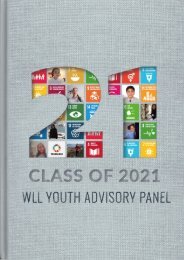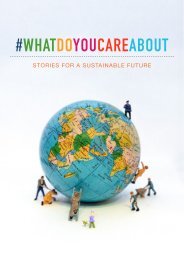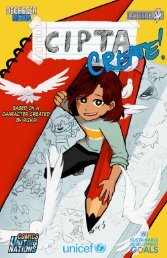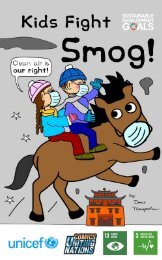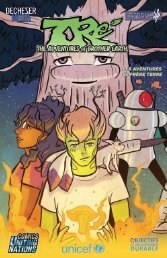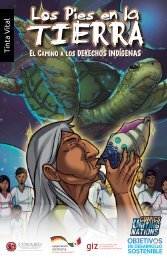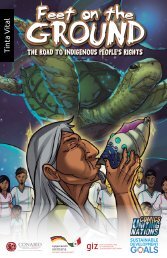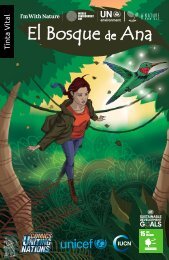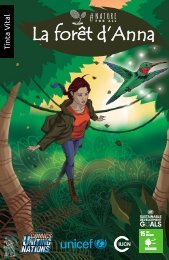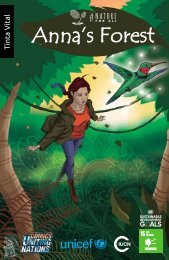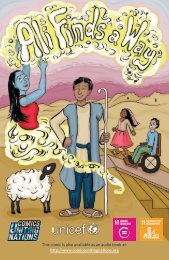The Epic Eco-inventions
You also want an ePaper? Increase the reach of your titles
YUMPU automatically turns print PDFs into web optimized ePapers that Google loves.
Illustrations by Carol Adlam<br />
1
Published and distributed by:<br />
Voices of Future Generations International Children’s Book Series<br />
Trust for Sustainable Living<br />
Hampstead Norreys, Berkshire, RG18 0TN, United Kingdom<br />
Tel: +44 (0)1635 202444<br />
Web: www.vofg.org<br />
Special thanks to René V. Steiner for layout and graphics support:<br />
www.steinergraphics.com.<br />
Text © Jona David 2017<br />
Illustrations © Carol Adlam 2017<br />
<strong>The</strong> Voices of Future Generations International Children’s Book Series:<br />
‘<strong>The</strong> <strong>Epic</strong> <strong>Eco</strong>-Inventions’ by Jona David (Europe/North America), illustrated by Carol Adlam<br />
‘<strong>The</strong> Great Green Vine Invention’ by Jona David (Europe/North America), illustrated by Carol Adlam<br />
‘<strong>The</strong> Tree of Hope’ by Kehkashan Basu (Middle East), illustrated by Karen Webb-Meek<br />
‘<strong>The</strong> Fireflies After the Typhoon’ by Anna Kuo (Asia), illustrated by Siri Vinter<br />
‘<strong>The</strong> Species-Saving Time Team’ by Lautaro Real (Latin America), illustrated by Dan Ungureanu<br />
‘<strong>The</strong> Sisters’ Mind Connection’ by Allison Lievano-Gomez (Latin America), illustrated by Oscar Pinto<br />
‘<strong>The</strong> Forward and Backward City’ by Diwa Boateng (Africa), illustrated by Meryl Treatner<br />
‘<strong>The</strong> Voice of an Island’ by Lupe Vaai (Pacific Islands), illustrated by Li-Wen Chu<br />
‘<strong>The</strong> Visible Girls’ by Tyronah Sioni (Pacific Islands), illustrated by Kasia Nieżywińska<br />
‘<strong>The</strong> Mechanical Chess Invention’ by Jona David (Europe/North America), illustrated by Dan Ungureanu<br />
CISDL<br />
Centre for International<br />
Sustainable Development Law<br />
This book is printed on recycled paper, using sustainable and low-carbon printing methods.
3
4
5
It gives me much pleasure to contribute this preface to a<br />
volume which is the first of a series of children’s books: Voices<br />
of Future Generations.<br />
This volume demonstrates how deeply children contemplate international peace and<br />
justice, sustainable development and human rights on which the future of civilisation<br />
depends. In a time of climate change, denigration of resources, environmental pollution<br />
and other challenges, this series will convey, in a charming way, the message of the younger<br />
generation to us, indicating their concern for the creation of the better world of the future.<br />
<strong>The</strong>y stress also the importance of the sacred trust that our generation carries, to help in<br />
constructing a better world for them.<br />
This imaginative little story is a call to all of us. It is a reminder of the importance of<br />
hope, courage, creativity, kindness and environmental responsibility—key qualities for our<br />
civilisations to flourish in the future. <strong>The</strong> child author, whom I have known nearly all of<br />
his life, has a bright and curious mind, a true heart, a courageous spirit and an intense<br />
commitment to protecting the earth and its peoples in peace. By helping his voice be heard,<br />
we offer hope.<br />
As lawyer and judge, and even more importantly as father and grandfather, I have had<br />
many occasions to contemplate the future world order of which our children will be a part.<br />
This book offers many perspectives on this all-important question. I warmly commend it<br />
and the series of which it forms a part.<br />
— HE Judge C.G. Weeramantry<br />
UNESCO Peace Education Prize Laureate,<br />
Former Vice-President, International Court of Justice & Patron,<br />
Centre for International Sustainable Development Law (CISDL),<br />
Councillor of the World Future Council<br />
At the World Future Council, we are dedicated to our responsibility<br />
to pass on a healthy planet to our children and grandchildren. By<br />
representing a strong voice and speaking out on behalf of future<br />
generations, we are working hard to close the gap between what<br />
we should be doing and what is already being done right now. This<br />
remarkable book series provides a voice to you, young people.<br />
Through these stories, we share two key promises that the world has<br />
made to our future generations: the Convention on the Rights of the<br />
Child and <strong>The</strong> Future We Want Declaration.<br />
— Jakob von Uexküll<br />
Founder and Chair, Management Board, World Future Council and<br />
Founder of the Right Livelihood Award<br />
6
Sustainable development has been the overarching goal of the international community<br />
since the 1992 Earth Summit of the United Nations. We know that using the limited<br />
resources provided by our Earth in a way that will leave little to future generations is an<br />
infringement of their human rights. Inter-generational equity is especially critical when<br />
children—the future generations—and their rights are involved.<br />
Science plays a key role in a more sustainable world. In this book, a little boy and his brother<br />
illustrate how science, when used in a just and honest way, could change the world for the<br />
better.<br />
<strong>The</strong> children’s book series Voices of Future Generations provides the ideal platform to link<br />
the issues of children’s rights and sustainable development as well as giving young authors<br />
the opportunity to show adults how they envisage the future. Dear young authors and<br />
readers—I look forward to learning from you.<br />
— Dr Julia Marton-Lefèvre<br />
Director General of the International Union for Conservation of Nature (IUCN) &<br />
Councillor of the World Future Council<br />
7
On the occasion of the 25th anniversary of the UN Convention on the Rights of the<br />
Child, I would like to stress the importance of listening to the voices of children. <strong>The</strong><br />
global challenges we face today, including conflict, epidemics and climate change,<br />
have particularly serious consequences for children and are of crucial concern to<br />
them. We need to involve children in our search for solutions to these challenges. All<br />
children should be invited to participate in this work. <strong>The</strong> book series ‘Voices of Future<br />
Generations’ aims to help realise the rights of children to participate and be heard in<br />
decisions which affect them. Jona’s voice is imaginative, joyful and true, representing<br />
children’s fears and hopes for future generations, and the Committee on the Rights of<br />
the Child fully endorses his call for environmental education programmes. I commend<br />
the series for its dedication to share children’s voices with readers globally. With their<br />
creativity, commitment and hopeful visions, the child authors can inspire us all to find<br />
the necessary will and resources to cooperate for sustainable solutions.<br />
— Professor Kristen Sandberg<br />
University of Oslo, Chairperson of the UN Committee on the Rights of the Child<br />
8
In a house by a lake in a very green town,<br />
there lived a boy and his little brother.<br />
Secretly, the boy was a Mad Genius Inventor.<br />
9
But no one knew this—not even his little<br />
brother, at first. <strong>The</strong> boy told no-one about<br />
his <strong>inventions</strong>. He did not want them to be<br />
scared or to laugh at him.<br />
His parents would sometimes tell him off<br />
when he came home with strange stains<br />
and tears in his clothes.<br />
Once, they even found a large piece of<br />
Delphiniorite (an element he had just<br />
discovered) in his sports bag.<br />
10
<strong>The</strong> boy and his little brother<br />
went to what the neighbours<br />
called ‘A Terribly Good<br />
School’.<br />
<strong>The</strong>y studied:<br />
maths,<br />
astro-physics,<br />
acrobatics,<br />
chemistry and biology,<br />
care of endangered species,<br />
virtual reality programming,<br />
telescope repair,<br />
geography,<br />
archery,<br />
music,<br />
AND<br />
gargoyle maintenance.<br />
11
<strong>The</strong>y also studied lots and lots of languages.<br />
<strong>The</strong> boy’s little brother was joyful. He loved<br />
music and spoke many languages.<br />
12
For birthdays and other celebrations he<br />
received many toys from his big brother.<br />
At first, the little brother did not realise that<br />
they were special. He thought his big brother<br />
had found his presents in the toyshops!<br />
He got ...<br />
13
1. A pet robot spider that ‘turns invisible’.<br />
1. BLUEPRINT NOTES: PET ROBOT SPIDER<br />
1. Force-field to bend light for invisibility effect<br />
2. Positronic brain<br />
3. Tiny nebula-fuel gas cells<br />
4. Special steel and crazy glue web spinner<br />
14
2. An anti-gravity train that builds<br />
its own tracks in the air.<br />
2. BLUEPRINT NOTES: ANTI-GRAVITY TRAIN<br />
1. Super light hyper-plastic<br />
2. Nanotech rods that rebuild and fold track<br />
3. Remote control pointer for directing train<br />
4. Nebula gas fuel cells<br />
15
3. An ultra-light eco-spaceship that paints<br />
words on the ceiling.<br />
3. BLUEPRINT NOTES: ECO-SPACESHIP<br />
1. Spray paint (evaporating ink)<br />
2. Super-cooled ink tank (non-evaporating)<br />
3. Positronic robot brain with language components<br />
4. Nebula gas fuel cells<br />
16
4. A light-maze that makes organic sweets.<br />
4. BLUEPRINT NOTES: LIGHT MAZE<br />
1. Transparent glass for laser-guiding tubes<br />
2. Circular base and sweet maker<br />
3. Delphiniorite and hyper-plastic for<br />
positronic scrambler unit<br />
4. Nebula gas, metal, and delphiniorite glass<br />
17
At school, the children loved the little<br />
brother’s stories.<br />
Everyone thought the stories just came<br />
from his imagination.<br />
Everyone—apart from the school bully.<br />
18
On their first day after Christmas break, the<br />
boys had their maths, science, and English<br />
lessons.<br />
<strong>The</strong> little brother’s pet robot spider had<br />
followed him to school—but he didn’t realise,<br />
because it was invisible.<br />
19
<strong>The</strong> spider robot went to all his classes.<br />
It particularly liked gymnastics.<br />
20
On the little brother and his little friends’<br />
way home the spider appeared and did some<br />
tricks for them.<br />
But when the school bully saw the robot<br />
spider, he threatened them and it.<br />
<strong>The</strong> little ones were scared, but they tried to<br />
be brave. <strong>The</strong>y called for help.<br />
21
Luckily, the Mad Genius Inventor Boy saw<br />
that his little brother was in trouble. Quickly,<br />
he activated a forcefield watch that he had<br />
just invented.<br />
It spun out, acting as a shield, driving the<br />
bully away.<br />
<strong>The</strong>ir friends were amazed!<br />
22
For the first time, the little brother started to<br />
see that maybe his toys were rather ... unusual.<br />
Afterwards, the boys invited their brave<br />
friends for a picnic.<br />
<strong>The</strong>y took their canoe out to the island in the<br />
middle of the lake.<br />
<strong>The</strong>y had a great time there, playing hide–<br />
and–seek with the pet robot spider.<br />
23
While they played, the little brother noticed<br />
a lever on the side of the island’s apple tree.<br />
‘I’ll come back soon and<br />
investigate’, he thought.<br />
24
<strong>The</strong> Inventor Boy had a habit of disappearing<br />
for hours at a time, especially in the early<br />
mornings when everyone else was asleep.<br />
<strong>The</strong> little brother decided<br />
to investigate the lever in<br />
the tree.<br />
So one afternoon, after<br />
school, he and his pet<br />
robot spider snuck away.<br />
25
When he got to the tree, he pulled<br />
the lever.<br />
A secret door opened up, with a<br />
marvellous glass elevator<br />
leading underground.<br />
26
27
28
As the little brother went deep<br />
into the Earth, a huge laboratory<br />
became visible.<br />
It was full of physics, chemistry<br />
and biology equipment, as well as<br />
many half-built <strong>inventions</strong>.<br />
<strong>The</strong>re were...<br />
29
1. Personal jet-packs with ‘solar propellors’.<br />
1. BLUEPRINT NOTES: JET PACKS<br />
1. Solar propellors for recharging while flying …<br />
2. Control belt for direction …<br />
3. Special sun-protection goggles with infra-red for<br />
night flying …<br />
4. Hydro-dynamic ‘underwater’ mode, with retractable<br />
scuba gear.<br />
30
2. A lightning re-charger that could charge<br />
non-electrical things.<br />
2. BLUEPRINT NOTES: LIGHTNING RE-CHARGER<br />
1. Lightning meltdown protector shells …<br />
2. Calibrator energy field matcher to avoid<br />
circuit burnout …<br />
3. Weathervane lightning attractor …<br />
4. Lightning storage cells.<br />
31
3. A magma drill that used<br />
geothermal power for<br />
construction projects.<br />
3. BLUEPRINT NOTES: GEOTHERMAL MAGMA DRILL<br />
1. Delphiniorite and diamond super-hard mobile drill-head<br />
2. Hyper-sonic boosters to soften materials prior to<br />
drilling<br />
3. Magma heat treatment to soften rock<br />
4. Geothermal super-conductor roots for power source<br />
32
4. A zoo of mechanical animals that could<br />
build their own ‘nano-habitats’.<br />
4. BLUEPRINT NOTES: NANO–ZOO<br />
1. Force-fields for habitats<br />
2. Nano-tech frames and tiny coloured marbles for<br />
building habitats inside globes<br />
3. Basic positronic units for learning dances,<br />
sounds and habitat-building skills<br />
33
<strong>The</strong>re was even a special nebula gas fuel cell<br />
invention.<br />
<strong>The</strong> fuel cell machine, which looked like a<br />
large computer with a satellite dish, could<br />
directly harness energy from the universe<br />
and store it in renewable energy cells, with<br />
clouds of swirling purple light.<br />
34
Suddenly, everything made sense! <strong>The</strong><br />
brilliant toys ... his brother’s disappearances<br />
... their home’s never-ending power supply.<br />
... and the special dashboard on their family<br />
hybrid car that read ‘flight mode!’<br />
<strong>The</strong> little boy was astonished. He realised his<br />
brother was a Mad Genius Inventor Boy!<br />
35
In one corner of the underground lab there<br />
was a strange trampoline platform. When the<br />
little brother and his pet robot spider climbed<br />
up on it, the bounce made them float. It was<br />
a disguised anti-gravity machine!<br />
<strong>The</strong> more they explored, the more they saw.<br />
One wall had a giant control panel, with<br />
screens and millions<br />
of buttons saying<br />
things like ‘activate<br />
force field’.<br />
Suddenly, the spider<br />
activated its chirp<br />
alarm.<br />
<strong>The</strong>y also heard footsteps<br />
— someone was coming!<br />
36
<strong>The</strong> hatch opened and the Mad Genius<br />
Inventor Boy appeared. When he saw his<br />
little brother, he laughed.<br />
‘I guess I couldn’t keep all this secret forever.’<br />
he said.<br />
<strong>The</strong>n the Inventor Boy showed him the tunnel<br />
he had come from.<br />
37
It was long and dark ...<br />
38
leading right underneath the lake!<br />
39
<strong>The</strong> tunnel came up under their own home,<br />
in the cupboard under the stairs!<br />
But while the boys were exploring, an awful<br />
thing happened.<br />
40
<strong>The</strong> school bully had taken a horribly loud<br />
motor boat out on the lake.<br />
When he saw the little brother’s canoe, he<br />
stopped at the island to look for him.<br />
He looked around for a while, and then he<br />
saw a secret hatch in the grass.<br />
41
When the bully saw the underground<br />
lab, he decided that all the amazing<br />
<strong>inventions</strong> could be used as weapons.<br />
He wanted to sell the new technologies<br />
to evil dictators to start new wars around<br />
the world.<br />
So he stuffed all the <strong>inventions</strong> into a big<br />
sack, and started to climb.<br />
Luckily, the Inventor Boy had not left his<br />
lab unprotected.<br />
An alarm sounded and lights came on.<br />
A special gravity force field came down<br />
like a heavy weight, slowing down the<br />
bully–thief so he could barely take a step.<br />
42
48<br />
43
Just as the bully struggled to the top of the<br />
ladder, the little brother’s pet robot spider<br />
darted forward.<br />
He threw out his web, like a bolt of silver<br />
lightning, tangling up the bully–thief. <strong>The</strong> bully<br />
fell to the ground, totally trapped.<br />
Soon the Inventor Boy and his little brother<br />
arrived, alerted by the alarm. <strong>The</strong>y took the<br />
bully–thief straight to the police. He was given<br />
two conducts, and agreed to do community<br />
service so he could learn to be a better person.<br />
44
<strong>The</strong> Mad Genius Inventor Boy, his little<br />
brother and their happy pet robot spider<br />
headed home in their canoe. <strong>The</strong>y decided it<br />
was time to tell everyone about the <strong>inventions</strong>.<br />
<strong>The</strong> little brother was worried that if they did<br />
not share them, others might steal them and<br />
use them for evil. ‘It’s worth being laughed<br />
at if your <strong>inventions</strong> can help clean up the<br />
Earth and end poverty’, he said.<br />
45
When they shared them, everyone was<br />
amazed. <strong>The</strong>ir parents even ran out and got<br />
licences for everything to protect the Mad<br />
Genius Inventor Boy’s work.<br />
46
47
<strong>The</strong>n the little brother packed the renewable<br />
energy machine, the anti-gravity trampoline,<br />
the invisibility gadget, and many other ecotoys<br />
for children into a large, sturdy suitcase.<br />
During the holidays, the little brother<br />
travelled the world, using his knowledge of<br />
many languages to share the Inventor Boy’s<br />
technologies with leaders of countries who<br />
wanted peace and a clean environment.<br />
48
Many schools were working to start new environmental<br />
education programmes, as a clean environment is<br />
every child’s human right.<br />
<strong>The</strong>y were very pleased to see him and the <strong>inventions</strong>,<br />
because he was so joyful, and the <strong>inventions</strong> were so<br />
clever and useful for learning about eco-science and<br />
technology.<br />
Meanwhile, the Inventor Boy was hard at work in his<br />
lab on his next ideas, and people all over the planet were<br />
using his new green <strong>inventions</strong> to learn and live better.<br />
And the Inventor Boy always asked his little brother<br />
when he got home—what did you see?<br />
And the little brother always answered, ‘Oh ... the<br />
future. <strong>The</strong> future we want.’<br />
49
Jona David (11) lives in Cambridge, UK and studies at King’s<br />
College School. He is a citizen of UK, Canada, Switzerland and<br />
Germany, and has authored several books about the Inventor<br />
Boy and his Little Brother.<br />
A Child Delegate to the 2012 UN Conference on Sustainable<br />
Development, he is a medallist of the International Schools<br />
Debates and Essay Competition on Sustainable Living. He also<br />
edits a website on eco-science and technology for kids, and is<br />
a Climate Justice Ambassador, having made a pledge to plant<br />
over 1000 trees across the world.<br />
Jona enjoys maths and science (especially astro-physics and<br />
botany), as well as chess, reading, polo, swimming, canoeing,<br />
aikido and the flute. He loves creating blueprints for eco<strong>inventions</strong>,<br />
but still needs to figure out how to build them.<br />
He thanks his parents, his Headmaster and his outstanding<br />
teachers at King’s. He especially thanks his little brother Nico,<br />
for his inspiration and help, and also Carol Adlam for her epic<br />
drawings.<br />
About the<br />
Illustrator<br />
Carol Adlam is a UK based artist, who draws and writes graphic<br />
novels and children’s books. She also makes reportage art for<br />
museums and heritage organisations. She is the winner of the<br />
2014 United Nations / World Future Council Children’s Book<br />
Illustration Award (Gold) and her work has been exhibited<br />
in Bologna, Cambridge, London, and Nottingham. Further<br />
information is available at www.caroladlam.co.uk.<br />
50
<strong>The</strong> United Nations Convention on the Rights of the Child<br />
All children are holders of important human rights. Twenty-five years ago<br />
in 1989, over a hundred countries agreed a UN Convention on the Rights<br />
of the Child. In the most important human rights treaty in history, they<br />
promised to protect and promote all children’s equal rights, which are<br />
connected and equally important.<br />
In the 54 Articles of the Convention, countries make solemn promises to<br />
defend children’s needs and dreams. <strong>The</strong>y recognize the role of children<br />
in realizing their rights, being heard and involved in decisions. Especially,<br />
Article 24 and Article 27 defend children’s rights to safe drinking water, good<br />
food, a clean and safe environment, health, quality of life. And Article 29<br />
recognizes children’s rights to education that develops personality, talents<br />
and potential, respecting human rights and the natural environment.<br />
<strong>The</strong> UN Sustainable Development Goals<br />
— Dr. Alexandra Wandel<br />
World Future Council<br />
At the United Nations Rio+20 Conference on Sustainable Development in<br />
2012, governments and people came together to find pathways for a safer,<br />
more fair, and greener world for all. Everyone agreed to take new action to<br />
end poverty, stop environmental problems, and build bridges to a more just<br />
future. In 283 paragraphs of <strong>The</strong> Future We Want Declaration, countries<br />
committed to defend human rights, steward resources, fight climate change<br />
and pollution, protect animals, plants and biodiversity, and look after<br />
oceans, mountains, wetlands and other special places.<br />
In the United Nations, countries are committing to 17 new Sustainable<br />
Development Goals for the whole world, with targets for real actions on<br />
the ground. Clubs, governments, firms, schools and children have started<br />
over a thousand partnerships, and mobilized billions, to deliver. <strong>The</strong> future<br />
we want exists in the hearts and minds of our generation, and in the hands<br />
of us all.<br />
— Vuyelwa Kuuya<br />
Centre for International Sustainable Development Law (CISDL)<br />
51
Thanks and Inspiring Resources<br />
‘Voices of Future Generations’ International Commission<br />
Warmest thanks to the International Commission, launched in 2014 by His Excellency Judge CG<br />
Weeramantry, UNESCO Peace Education Research Award Laureate, which supports, guides and profiles<br />
this new series of Children’s Books Series, including Ms Alexandra Wandel (WFC), Dr Marie-Claire<br />
Cordonier Segger (CISDL), Dr Kristiann Allen (New Zealand), Ms Irina Bokova (UNESCO), Mr Karl<br />
Hansen (Trust for Sustainable Living), Ms Emma Hopkin (UK), Dr Ying-Shih Hsieh (EQPF), Dr Maria<br />
Leichner-Reynal (Uruguay), Ms Melinda Manuel (PNG), Ms Julia Marton-Lefevre (IUCN), Dr James<br />
Moody (Australia), Ms Anna Oposa (<strong>The</strong> Philippines), Professor Kirsten Sandberg (UN CRC Chair), Ms<br />
Patricia Chaves (UN DSD), Dr Marcel Szabo (Hungary), Dr Christina Voigt (Norway), Ms Gabrielle<br />
Sacconaghi-Bacon (Moore Foundation), Ms Marcela Orvañanos de Rovzar (UNICEF Mexico) and others.<br />
<strong>The</strong> World Future Council consists of 50 eminent global changemakers from across the globe. Together,<br />
they work to pass on a healthy planet and just societies to our children and grandchildren. (www.<br />
worldfuturecouncil.org)<br />
United Nations Education, Science and Culture Organization (UNESCO) which celebrates its 70th<br />
Anniversary throughout 2015, strives to build networks among nations that enable humanity’s moral<br />
and intellectual solidarity by mobilizing for education, building intercultural understanding, pursuing<br />
scientific cooperation, and protecting freedom of expression. (en.unesco.org)<br />
<strong>The</strong> United Nations Committee on the Rights of the Child (CRC) is the body of 18 independent experts<br />
that monitors implementation of the Convention on the Rights of the Child, and its three Optional<br />
Protocols, by its State parties. (www.ohchr.org)<br />
United Nations Environment Programme (UNEP) provides leadership and encourages partnership in<br />
caring for the environment by inspiring, informing, and enabling nations and peoples to improve their<br />
quality of life without compromising that of future generations. (www.unep.org)<br />
International Union for the Conservation of Nature (IUCN) envisions a just world that values and<br />
conserves nature, working to conserve the integrity and diversity of nature and to ensure that any use of<br />
natural resources is equitable and ecologically sustainable. (www.iucn.org)<br />
Centre for International Sustainable Development Law (CISDL) supports understanding, development<br />
and implementation of law for sustainable development by leading legal research through scholarship and<br />
dialogue, and facilitating legal education through teaching and capacity-building. (www.cisdl.org)<br />
Trust for Sustainable Living and its Living Rainforest Centre exist to further the understanding<br />
of sustainable living in the United Kingdom and abroad through high-quality education. (www.<br />
livingrainforest.org)<br />
Environmental Quality Protection Foundation (EQPF) established in 1984 is the premier ENGO in Taiwan.<br />
Implementing environmental education, tree plantation, and international participation through coordinating<br />
transdisciplinarity resources to push forward environmental and sustainable development in our time.<br />
52
About the ‘Voices of Future Generations’ Series<br />
To celebrate the 25th Anniversary of the United Nations Convention on the Rights of the Child, the<br />
Voices of Future Generations Children’s Book Series, led by the United Nations and a consortium of<br />
educational charities including the World Future Council (WFC), the Centre for International Sustainable<br />
Development Law (CISDL), the Environmental Quality Protection Foundation (EQPF), the Fundacion<br />
<strong>Eco</strong>s and the Trust for Sustainable Living (TSL) among others, also the Future Generations Commissioners<br />
of several countries, and international leaders from the UN Division for Sustainable Development, the UN<br />
Committee on the Rights of the Child, the UN Education, Science and Culture Organisation (UNESCO),<br />
the International Union for the Conservation of Nature (IUCN), and other international organizations,<br />
has launched the new Voices of Future Generations Series of Children’s Books.<br />
Every year we feature stories from our selected group of child authors, inspired by the outcomes of the<br />
Earth Summit, the Rio+20 United Nations Conference on Sustainable Development (UNCSD) and<br />
the world’s Sustainable Development Goals, and by the Convention on the Rights of the Child (CRC)<br />
itself. Our junior authors, ages 8-12, are concerned about future justice, poverty, the global environment,<br />
education and children’s rights. Accompanied by illustrations, each book profiles creative, interesting and<br />
adventurous ideas for creating a just and greener future, in the context of children’s interests and lives.<br />
We aim to publish the books internationally in ten languages, raising the voices of future generations and<br />
spread their messages for a fair and sustainable tomorrow among their peers and adults, worldwide. We<br />
welcome you to join us in support of this inspiring partnership, at www.vofg.org.<br />
53
54
55
“This wonderfully inventive story reflects a child’s natural aspiration to<br />
better the world and protect our planet, providing an inspiring resource for<br />
teachers and students alike. Through education, we must build peace in<br />
young minds and nurture children’s creativity to shape more sustainable, just<br />
and peaceful societies. This is a message that UNESCO is promoting globally<br />
throughout the year long celebrations of its 70th anniversary.”<br />
— Irina Bokova<br />
Director-General, UNESCO<br />
“This extraordinary child’s future, with scientific curiosity and courage, can<br />
become the new reality.”<br />
— Prof. Dr. Ernst Ulrich von Weizsacker<br />
Lead Author of Factor Five, and Co-Chair,<br />
UNEP International Resource Panel<br />
“A terrific eco-<strong>inventions</strong> tale! Like a satellite, it shines with creativity and<br />
whimsy, a must-read for young scientists.”<br />
— Dr James Bradfield Moody<br />
Author of <strong>The</strong> Sixth Wave and ‘<strong>The</strong> New Inventors’<br />
TV Panellist of Australia<br />
UNESCO Voices of Future Generations | Children’s Book Series 2<br />
<strong>The</strong> <strong>Epic</strong> <strong>Eco</strong>-Inventions | 1<br />
56



